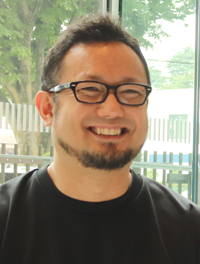Name of supervisor: Yoshikazu Tanaka DVM, PhD
Position: Professor
researchmap
KAKEN researcher number: 50291159
Main research theme: Development of Prevention and Treatment of Feline Infectious Peritonitis
Research keywords: Viruses, infectious diseases, molecular and cellular biology, proteolysis
Lab location: Laboratory of Veterinary Hygiene, 3rd Floor, D Building
E-mail: ytanaka(@mark)nvlu.ac.jp
Research
Feline coronavirus infects approximately 70% of domestic cats worldwide, and 7–10% of these cats develop feline infectious peritonitis (FIP), an infectious disease with symptoms such as ascites and pleural effusions, neuropathy, uveitis, and pyogenic granulomatitis that results in death in almost 100% of cases. There is no effective vaccine against FIP, and an unapproved drug that has shown significant efficacy has only recently been discovered. Even when antiviral drugs are developed, resistant viruses emerge the following year. Thus, the fight against infectious diseases is ongoing, and multidrug therapy, in which multiple drugs are simultaneously administered, is the most effective means of combating infectious diseases. Although a variety of anti-FIP drugs have been discovered, only a few are clinically effective. Therefore, there is an ongoing need to identify new antiviral agents and clinically validate their efficacies. Feline coronaviruses are more virulent than COVID-19 and do not always enter remission, even if the same drug is prescribed. The virus replicates in a slightly different manner from COVID-19, and there are many questions that need to be answered to develop antiviral drugs. We are conducting daily research with the goal of developing antiviral drugs that can treat as many infected cats as possible.
Guidance policy for graduate students
Viruses are characterized by their inability to replicate outside of living cells. Therefore, cell culture is essential to using viruses as research materials. In addition, because viruses utilize cellular physiological functions during replication, it is necessary to understand normal cell physiology to inhibit replication. In this laboratory, it is important to understand papers on virology and infectious diseases. However, it is also necessary to grasp the knowledge of cellular physiology and always think about how to apply it to one’s own experimental themes. Therefore, it is necessary to carefully read journals specializing in cell biology presented during literature seminars to obtain a broad range of knowledge. In addition, since viruses are invisible, it is necessary to conduct mRNA quantifications (using quantitative PCR), protein analysis, observations using confocal laser microscopy, and statistical processing and use bioinformatics tools to indirectly visualize and quantify the results of mRNA quantification. In addition, target proteins are forced or constantly expressed in cells, and sometimes target genes are knocked out using the CRISPR-Cas9 system. We guide graduate students to master these techniques and publish the results obtained.
Publications
1.Detection of anti-feline infectious peritonitis virus activity of a Chinese herb extract using geneLEAD VIII, a fully automated nucleic acid extraction/quantitative PCR testing system.
Rui Nishijima, Takuro Endo, Enkhjavkhlan Gankhuyag, Shwe Thiri Maung Maung Khin, Sheikhy Mohammad Jafar, Yuta Shinohara, Yoshikazu Tanaka, Kazumi Sawakami, Masafumi Yoda, Tetsuya Furuya. The Journal of veterinary medical science 2023, 85(4):443-446.
2.Canine Mammary Tumor Cell Lines Derived from Metastatic Foci Show Increased RAD51 Expression but Diminished Radioresistance via p21 Inhibition. Kei Shimakawa, Kazuhiko Ochiai, Sachi Hirose, Eri Tanabe, Masaki Michishita, Motoharu Sakaue, Yasunaga Yoshikawa, Masami Morimatsu, Tsuyoshi Tajima, Masami Watanabe, Yoshikazu Tanaka. Veterinary sciences 2022, 9(12):703.
3.Ionophore Antibiotics Inhibit Type II Feline Coronavirus Proliferation In Vitro. Yoshikazu Tanaka, Eri Tanabe, Yuki Nonaka, Mitsuki Uemura, Tsuyoshi Tajima, Kazuhiko Ochiai
Viruses 2022, 14(8):1734-1734.
4.In vitro anticancer effects of alpelisib against PIK3CA‑mutated canine hemangiosarcoma cell lines. Marika Maeda, Kazuhiko Ochiai, Masaki Michishita, Masami Morimatsu, Hiroki Sakai, Nayuta Kinoshita, Motoharu Sakaue, Eri Onozawa, Daigo Azakami, Masami Yamamoto, Katsumi Ishioka, Takuya Sadahira, Masami Watanabe, Yoshikazu Tanaka. Oncology reports 2022, 47(4):84.
5.The effects of migration on the immunity of Black-headed gulls (Chroicocephalus ridibundus: Laridae). Nana Ushine, Osamu Kurata, Yoshikazu Tanaka, Tatsuo Sato, Yoshihiro Kurahashi, Shin-Ichi Hayama. The Journal of veterinary medical science 2020, 82(11):1619-1626.
Name of supervisor: Kazuhiko Ochiai DVM, PhD
Position: Associate Professor
researchmap
KAKEN researcher number: 30550488
Main research theme: Research on cancer-related genes in companion animals
Research keywords: Genes, Proteins, Cancer, Cell Biology, Molecular Biology
Lab location: Laboratory of Veterinary Hygiene, 3rd Floor, D Building
E-mail: kochiai(@mark)nvlu.ac.jp
Research
Humans have domesticated various animals and improved their breeding over the years. Dogs have achieved unparalleled breed diversity at an astonishing rate since their domestication approximately 10,000 years ago. I have found a connection between the “extremely high incidence of mammary tumors in dogs” and the “great diversity of canine breeds.” Therefore, I am conducting research to elucidate the mechanism of mammary tumor development in dogs and use dogs as a landmark for determining the rate of evolution of a species. BRCA2, a human hereditary breast cancer-causing gene whose mutations lead to mammary tumorigenesis, maintains genome stability by performing homologous recombination repair at DNA double-strand breaks in cooperation with interacting molecules such as RAD51. Homologous recombination repair is involved in paternally derived chromosome shuffling during gametogenesis. We predict that canines with several mammary tumors and high breed diversity may be characterized using this mechanism. Therefore, our research focuses on analyzing the interaction patterns of related molecular groups and quantifying and comparing the efficiency of homologous recombination (see the image of the research content).
We are also conducting mutation searches and functional analyses of diverse cancer-related genes in companion animals and are developing novel early genetic diagnostic methods and therapeutic strategies.
Guidance policy for graduate students
I taught three graduate students in the master’s program in Veterinary Health Nursing. My teaching policy was to interact with students to provide the most appropriate guidance for their situations. Students who have graduated from undergraduate school and started working acquire various skills in society while earning income. In contrast, graduate students continue their studies while paying their tuition fees. Therefore, I believe it is the responsibility of graduate school supervisors to guide students in acquiring additional skills and expanding their future possibilities while still in school.
We will provide research guidance with the aim of obtaining tangible results so that graduate students, who are the eggs of researchers, experience daily growth every day and continue their research without feeling indebted to their classmates who are active in society. Research achievements such as papers and conference presentations are not only the embodiment of possibilities for the future but also the seeds of opportunities that lead to various financial supports. We share this value with our students and aim for strategic graduate school life.
Publications
1.Kawakami S, Ochiai K. et al., 2020. (Graduate Student First Author)
Novel canine isocitrate dehydrogenase 1 mutation Y208C attenuates dimerization ability.
Oncol Lett. 2020 Dec;20(6):351. doi: 10.3892/ol.2020.12214.
2.Uemura M, Ochiai K, et al., 2020. (Graduate Student First Author)
The canine RAD51 mutation leads to the attenuation of interaction with PALB2.
Vet Comp Oncol. 2020 Jun;18(2):247-255. doi: 10.1111/vco.12542.
3.Kawakami S, Ochiai K. et al., 2018. (Graduate Student First Author)
R132 mutations in canine isocitrate dehydrogenase 1 (IDH1) lead to functional changes.
Vet Res Commun. 2018 Mar;42(1):49-56. doi: 10.1007/s11259-017-9707-8.
4.Kawakami S, Ochiai K. et al., 2018. (Graduate Student First Author)
Functional alteration of canine isocitrate dehydrogenase 2 (IDH2) via an R174K mutation.
J Vet Med Sci. 2018 Jan 27;80(1):85-91. doi: 10.1292/jvms.17-0362.
5.Kato Y, Ochiai K. et al., 2017. (Graduate Student First Author)
Canine REIC/Dkk-3 interacts with SGTA and restores androgen receptor signalling in androgen-independent prostate cancer cell lines.
BMC Vet Res. 2017 Jun 9;13(1):170. doi: 10.1186/s12917-017-1094-4.
6.Kato Y, Ochiai K. et al., 2015. (Graduate Student First Author)
Molecular cloning of canine co-chaperone small glutamine-rich tetratricopeptide repeat-containing protein α (SGTA) and investigation of its ability to suppress androgen receptor signalling in androgen-independent prostate cancer.
Vet J. 2015 Nov;206(2):143-8. doi: 10.1016/j.tvjl.2015.08.002.


